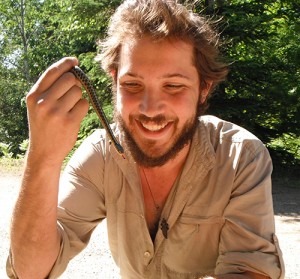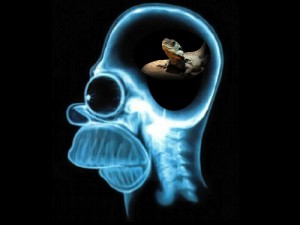
James Baxter-Gilbert is the lab brew-master, general trouble-shooter, answers public enquiries and assists in the lab and field. Oh yes, he has also started a PhD on water dragons! Mid-April 2015-
In broad terms, for his PhD, James will be working on behavioural, cognitive, and physiological adaptations by Eastern Water Dragons (Intellagama lesueurii) to anthropogenic landscapes.
Background
A prominent driver of biodiversity loss is habitat degradation and fragmentation resulting from human development and urbanization. Reptiles have suffered some of the most substantial population losses of all vertebrates; however, there are a certain reptile species that thrive in urban landscapes. What allows certain reptiles to survive and exploit urban landscapes where most cannot? Urban areas are a novel landscape that selects for particular life-history and behavioural characteristics, including high behavioural flexibility, altered stress physiology, modified morphologies, and increased reproductive output. James’ PhD research will examine if urban Eastern Water Dragon populations are able to thrive because of population-level adaptations to selective pressures of city life.
Publications
Baxter-Gilbert, J. 2016. Heterospecific coprophagy in an Eastern Water Dragon (Intellagama lesueurii lesueurii; GRAY 1831). Herpetofauna, accepted 9 August 20016
Riley, J.L., J.H. Baxter-Gilbert and J.D. Litzgus. Tails and tribulations: a comparison of external transmitter attachment methods for snakes. Wildlife Society Bulletin, accepted 6 December 2016, ms#WSB-16-079
Davy, C.M., G.F. Mastromonaco, J.L. Riley, J.H. Baxter-Gilbert, H.W. Mayberry and C.K.R. Willis. 2016. Physiological carry-over effects in bats exposed to an emerging pathogen implicate an overlooked potential driver of the extinction vortex. Conservation Biology, doi:10.1111/cobi.12841
Riley, J.L., Baxter-Gilbert, J.H., Guglielmo, C.G., and Litzgus, J.D. 2016. Scanning snakes to measure condition: a validation of quantitative magnetic resonance. Journal of Herpetology, 50(4): 627-632.
Baxter-Gilbert, J. and Riley, J.L. 2015. Intellagama lesuerii lesuerii (Eastern Water Dragon) Trifid Tail. Herpetological Review, 46: 433-434.
Baxter-Gilbert, J.H., Riley, J.L., Neufeld, C., Lesbarrères, D., and Litzgus, J.D. 2015. Road mortality responsible for billions for pollinating insect deaths annually. Journal of Insect Conservation, 19(5): 1029-1035.
Baxter-Gilbert, J. H., Riley, J. L., Lesbarrères, D., & Litzgus, J. D. (2015). Mitigating Reptile Road Mortality: Fence Failures Compromise Ecopassage Effectiveness. PloS one, 10(3): e0120537.
Baxter-Gilbert, J. H. , Riley, J. L., Moldowan, P. D., & Litgus, J. D. (2015). Sistrurus cantenatus cantenatus (Eastern Massasauga) and Nerodia sipedon sipedon (Northern Watersnake), Diet and foreign object. Herpetological Review, 46(1): 107.
Baxter-Gilbert, J. H., Riley, J. L., Mastromonaco, G. F., Litzgus, J. D., & Lesbarrères, D. (2014). A novel technique to measure chronic levels of corticosterone in turtles living around a major roadway. Conservation Physiology 2(1): cou036.
Baxter-Gilbert, J., Riley, J.L., and Litzgus, J.D. 2013. Plestiodon fasciatus (Five-lined Skink), Artificial habitat use. Herpetological Review 44(4): 680-681.
Baxter-Gilbert, J., Riley, J.L., and Litzgus, J.D. 2013. Sistrurus catenatus catenatus (Eastern Massasauga), Diet. Herpetological Review 44(3): 526-527.
Baxter-Gilbert, J., Riley, J.L., and Litzgus, J.D. 2013 Chrysemys picta marginata (Midland Painted Turtle) and Emydoidea blandingii (Blanding’s Turtle), Hatchling mortality. Herpetological Review 44(2): 303-304.
Baxter-Gilbert, J., Riley, J.L., and Litzgus, J.D.Baxter-Gilbert, J., J.L. Riley and J.D. Litzgus. 2013. Chrysemys picta marginata (Midland Painted Turtle), Avian predation. Herpetological Review 44(2): 302-303.
Follow James on Twitter: @JamesBG27


